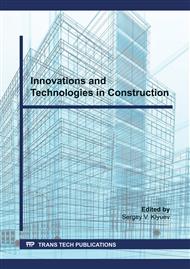[1]
L.A. Wright, S. Kemp, I. Williams, Carbon footprinting,: Towards a universally accepted definition, Carbon Manag. (2011). https://doi.org/10.4155/cmt.10.39.
DOI: 10.4155/cmt.10.39
Google Scholar
[2]
X.Y. Zhuang, L. Chen, S. Komarneni, C.H. Zhou, D.S. Tong, H.M. Yang, W.H. Yu, H. Wang, Fly ash-based geopolymer: clean production, properties and applications, J. Clean. Prod. 125 (2016) 253–267. https://doi.org/10.1016/J.JCLEPRO.2016.03.019.
DOI: 10.1016/j.jclepro.2016.03.019
Google Scholar
[3]
A. Nazari, J.G. Sanjayan, Handbook of Low Carbon Concrete, 2016. https://doi.org/10.1016/c2015-0-01844-5.
Google Scholar
[4]
R. Fediuk, R. Timokhin, A. Mochalov, K. Otsokov, I. Lashina, Performance properties of high-density impermeable cementitious paste, J. Mater. Civ. Eng. (2019). https://doi.org/10.1061/(ASCE)MT.1943-5533.0002633.
DOI: 10.1061/(asce)mt.1943-5533.0002633
Google Scholar
[5]
S. V. Klyuev, T.A. Khezhev, Y. V. Pukharenko, A. V. Klyuev, Fiber concrete on the basis of composite binder and technogenic raw materials, Mater. Sci. Forum. (2018). https://doi.org/10.4028/www.scientific.net/MSF.931.603.
DOI: 10.4028/www.scientific.net/msf.931.603
Google Scholar
[6]
R.S. Fediuk, A.K. Smoliakov, R.A. Timokhin, V.O. Batarshin, Y.G. Yevdokimova, Using thermal power plants waste for building materials, in: IOP Conf. Ser. Earth Environ. Sci., 2017. https://doi.org/10.1088/1755-1315/87/9/092010.
DOI: 10.1088/1755-1315/87/9/092010
Google Scholar
[7]
S.V. Klyuev, A.V. Klyuev, E.S. Shorstova, Fiber concrete for 3-d additive technologies, Materials Science Forum. 974 (2019) 367–372.
DOI: 10.4028/www.scientific.net/msf.974.367
Google Scholar
[8]
S.V. Klyuev, A.V. Klyuev, E.S. Shorstova, The micro silicon additive effects on the fine-grassed concrete properties for 3-d additive technologies, Materials Science Forum. 974 (2019) 131–135.
DOI: 10.4028/www.scientific.net/msf.974.131
Google Scholar
[9]
M. Mazloom, A.A. Ramezanianpour, J.J. Brooks, Effect of silica fume on mechanical properties of high-strength concrete, Cem. Concr. Compos. (2004). https://doi.org/10.1016/S0958-9465(03)00017-9.
DOI: 10.1016/s0958-9465(03)00017-9
Google Scholar
[10]
M.A. Mosaberpanah, O. Eren, A.R. Tarassoly, The effect of nano-silica and waste glass powder on mechanical, rheological, and shrinkage properties of UHPC using response surface methodology, J. Mater. Res. Technol. (2018). https://doi.org/10.1016/j.jmrt.2018.06.011.
DOI: 10.1016/j.jmrt.2018.06.011
Google Scholar
[11]
R.S. Fediuk, V.S. Lesovik, A.P. Svintsov, A.V. Mochalov, S.V. Kulichkov, N.Y. Stoyushko, N.A. Gladkova, R.A. Timokhin, Self-compacting concrete using pretreatmented rice husk ash, Mag. Civ. Eng. 79 (2018). https://doi.org/10.18720/MCE.79.7.
Google Scholar
[12]
S.V. Klyuev, A.V. Klyuev, E.S. Shorstova, Fiber concrete for 3-d additive technologies, Construction Materials and Products. 2 (4) (2019) 14–20.
DOI: 10.34031/2618-7183-2019-2-4-14-20
Google Scholar
[13]
Yu.V. Denisova, Additive technology in construction, Construction Materials and Products. 1(3) (2018) 33–42.
Google Scholar
[14]
P.S. Deb, P.K. Sarker, S. Barbhuiya, Sorptivity and acid resistance of ambient-cured geopolymer mortars containing nano-silica, Cem. Concr. Compos. (2016). https://doi.org/10.1016/j.cemconcomp.2016.06.017.
DOI: 10.1016/j.cemconcomp.2016.06.017
Google Scholar
[15]
D.Y. Yoo, N. Banthia, Mechanical properties of ultra-high-performance fiber-reinforced concrete: A review, Cem. Concr. Compos. (2016). https://doi.org/10.1016/j.cemconcomp.2016.08.001.
DOI: 10.1016/j.cemconcomp.2016.08.001
Google Scholar
[16]
E.P. Kearsley, P.J. Wainwright, Porosity and permeability of foamed concrete, Cem. Concr. Res. (2001). https://doi.org/10.1016/S0008-8846(01)00490-2.
Google Scholar
[17]
I. Mandilaras, M. Stamatiadou, D. Katsourinis, G. Zannis, M. Founti, Experimental thermal characterization of a Mediterranean residential building with PCM gypsum board walls, Build. Environ. (2013). https://doi.org/10.1016/j.buildenv.2012.12.007.
DOI: 10.1016/j.buildenv.2012.12.007
Google Scholar
[18]
B. Zegardło, M. Szeląg, P. Ogrodnik, Ultra-high strength concrete made with recycled aggregate from sanitary ceramic wastes – The method of production and the interfacial transition zone, Constr. Build. Mater. (2016). https://doi.org/10.1016/j.conbuildmat.2016.06.112.
DOI: 10.1016/j.conbuildmat.2016.06.112
Google Scholar
[19]
A. Mohajerani, J. Vajna, T.H.H. Cheung, H. Kurmus, A. Arulrajah, S. Horpibulsuk, Practical recycling applications of crushed waste glass in construction materials: A review, Constr. Build. Mater. (2017). https://doi.org/10.1016/j.conbuildmat.2017.09.005.
DOI: 10.1016/j.conbuildmat.2017.09.005
Google Scholar
[20]
G. Murali, K. Ramprasad, A feasibility of enhancing the impact strength of novel layered two stage fibrous concrete slabs, Eng. Struct. (2018). https://doi.org/10.1016/j.engstruct.2018.08.034.
DOI: 10.1016/j.engstruct.2018.08.034
Google Scholar


